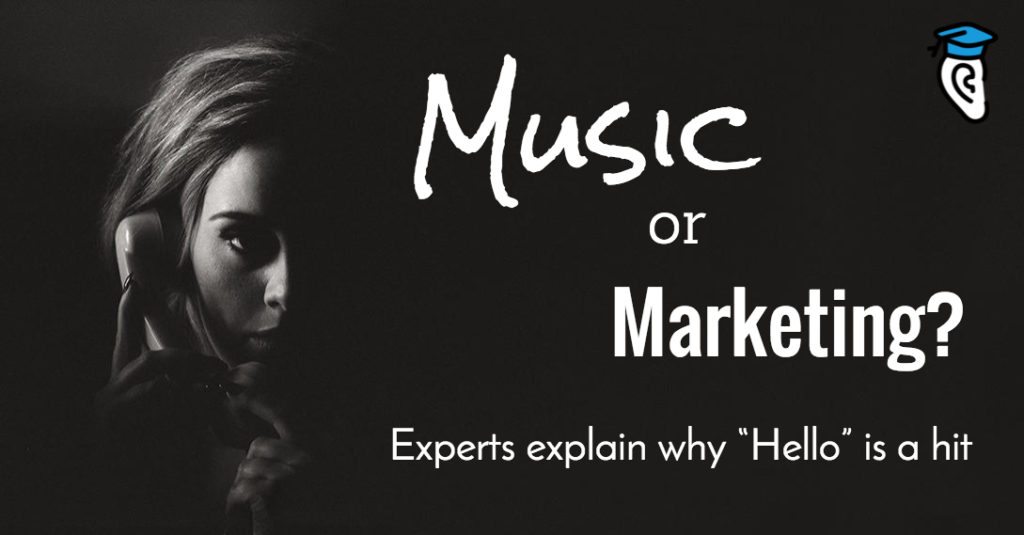Adele’s new song “Hello” has been a phenomenal hit around the world but opinions are divided about whether the song itself is deserving of such success – or if it’s simply the result of clever marketing to a hungry fanbase. We asked five experts on music theory and analysis to give their opinions on what’s responsible for the massive success of “Hello”.
Since its release on the 23rd October Adele’s first single in three years has been breaking digital records all over the internet. It clocked up one million YouTube plays per hour in its first two days of release and two people were Shazaming the track every second in its first 24 hours.
“No single has ever been Shazamed so much in its first day”
On Friday it was unsurprisingly number one in the UK chart – the biggest number one for three years, in fact – and it has now become the first song to sell over 1 million U.S. downloads in a week.
The opening of the song is being described as “iconic” by the BBC and the song seems to have moved its listeners to tears in an inexplicable way. Even Adele herself cried when the single was played for the first time on BBC Radio 1. It seems the only person who hasn’t been bewitched by the song is Lionel Richie, who claims the the new Adele single resembles his 80s hit of the same name.
The internet is full of analysis. Why is she using a flip-phone in the video? There’s outrage from Brits at the way she makes a cup of tea. Is the song about the same guy as her previous hit “Someone like you”? Already there are numerous cover versions and (of course) a Lionel Richie mashup.
The evidence suggests there is something unique about “Hello”.
The release date of the single was a closely guarded secret. A 30-second teaser, without introduction, was first heard during an advertisement break on the X-Factor, sparking social media speculation that Adele “was back”.
Was it recognition of her unmistakeable voice that sparked her fans to start the hype about the single’s pending release?
Is it the lyrics or the song’s theme, tugging at everyone’s heartstrings?
Or is there something in the music itself which has made this song an unrivalled success?
We asked the experts what they thought.
Read on to find out what David Rees of Dave Conservatoire, Ethan Hein of NYU’s Music Experience Design Lab, Christopher Sutton of Musical U, Daniel Müllensiefen of the Music, Mind, and Brain research group at the University of London, and music informatics researcher Matthias Mauch think is responsible for “Hello” becoming such a smash hit.
We want to know your opinion too. Don’t miss the chance to cast your vote in our poll below: is the song’s success due to music or marketing?
David Rees (Dave Conservatoire)

I teach a first year music theory class at Ravensbourne College. This week we explored the music of Adele’s new song “Hello” to see if we might reveal why it has been such a huge success.
While some have been quick to point out the similarity to other “telephone songs”, “Hello” does have interesting musical features.
We are not in standard major or minor key here, but instead something older, the aeolian mode. It allows for some less common harmonic colours in the song’s simple four-chord scheme. A soupy reverb-laden sound draws us in and helps set the scene for a nostalgic look back in time, much like Lana del Rey’s 2011 song “Video Games”. There is a rich palette of instrumental colours, combining electronic sounds alongside the track’s simple piano part.
However, like “Rolling in the Deep”, “Hello” principally serves as a vehicle for Adele’s exceptionally powerful and emotive voice.
The hushed, almost speech-like nature of the verses only highlight the emotion and impact of the song’s choruses when they arrive. Higher in Adele’s range, during these moments the song becomes something of an anguished cry.
We are particularly drawn to the words “side”, “times” and “tried”, where Adele’s long melody notes ache, clashing against the harmony beneath. As the song continues, more and more layers build to make the final performances of the chorus weightier still.
Big, emotional top notes have been used by composers for centuries to make a deep impact on listeners. Operatic arias often build towards a particularly high, long note, marking an emotional and musical climax.
The same is true here.
Adele’s performances express a direct kind of emotional connection that her audience clearly loves. She has mastered a range of vocal colours and techniques, but cuts particularly through her long, held, higher notes – a key feature of both “Hello” and “Rolling in the Deep”.
This is, in our view, Adele’s secret weapon.
Ethan Hein (NYU)

We can never know why one song is a bigger hit than another, but I can say with confidence that Adele’s overall popularity is the result of her being unbelievably good at what she does.
Her voice is a once-in-a-generation miracle, and for plenty of listeners, that’s enough. She has enough grit to make you believe her, but it comes with all the glossily Auto-Tuned perfection we’ve come to expect from our pop songs. Adele’s material is soulful enough to grab you emotionally, and conservative enough not to scare away any major listening constituency. The overall feel is retro enough for your parents, yet current enough for tweens. There’s no profanity, no street slang, and no hard-edged drum machines or synths. But there’s enough of an edge to keep from slipping into Norah Jones Sunday brunch territory.
Adele is exceptionally gifted at forging an instant emotional connection. The song is telling a sad story, but not so sad as to bring you down excessively. It’s easy to imaginatively put yourself in her position as the narrator, or in the position of the person she’s addressing, or both. The lyrics are laden with comforting clichés. The internet has already pointed out the opening line’s obvious association to Lionel Richie. The phrase “California dreamin'” evokes The Mamas and The Papas. Adele talks about calling someone who “isn’t home,” which is a sweet anachronism of the pre-cell-phone era.
While the song itself could have been written in 1972, the production has a few touches that locate it unambiguously in the present. In the seventies, Adele’s voice would have been soaked in natural reverb; now she gets a blend of digital reverb and delay that keeps her sounding crisp and immediate. The piano is reassuringly acoustic, but other sounds are more technological: the rising backwards-masked ambience, the filtered drum loops, the quantized rhythm.
The melody is a blend of bluesy pentatonicism and stepwise walks down the scale. Adele has a strong blues feel to her delivery, but this song has no other obvious blues signifiers like tritones or major/minor clashes. The chord progression is straightforward diatonicism. I’m sure someone else has done a thorough analysis. I’ll just point out that the tune uses a few harmonically static loop structures, with so little functional movement as to feel modal. A seventies tune would probably have a bridge in a new key, maybe on the fourth of the home key. I like that modern pop has so little harmonic activity; it keeps your attention on the sounds and the beats. If I want interesting chord progressions, I have jazz for that.
As a general matter, Americans love black music, especially when delivered by white people. We love the idea of soul, but we don’t like to have to confront uncomfortable racial politics. Like Amy Winehouse and Dusty Springfield, Adele has more going for her creatively than just appropriation. Reggie Watts, in his comedy special A Live In Central Park, describes Adele as “a black woman that got beamed into the consciousness of a white girl [and] completely neutralized the idea of racism.” It’s a nice idea, isn’t it?
Christopher Sutton (Musical U)

To me there are three things which are notable about Adele’s “Hello”.
The first is the vocals. If you applied a musical 80/20 analysis to this song I think you’d have to conclude that the vocals are 80% of what makes the song special. Replace any other musical component and you’d still have a decent song, but replace the vocals and there’s really not much left. Adele’s voice is broad in its tone and she has a timbre that sounds “high definition” compared to some of the simpler-sounding pop voices out there. I’m not sure it’s unique or immediately recognisable, but it’s certainly distinctive and has an undeniable richness to it. This allows for a lush overall sound in her songs, and a recording you can listen to carefully multiple times and still find new ways to appreciate.
The second thing I think is notable about this song is the chord progression. It’s remarkable that one of the most successful songs of the last decade is a four chord song. Not only that but it’s the classic combination of I, IV, V, and vi chords throughout – specifically the version starting from the minor chord which is so common as to have its own name and dedicated website. The order changes around a bit to create a slightly different musical journey in the chorus than the verse, but we’re still talking about the same four chords that have powered thousands of pop and rock hits.
To put it another way: what’s remarkable about the harmony is that it’s about as unremarkable as could be. It’s a clear demonstration that you don’t need to get adventurous with your harmonies to create a hit.
The third thing is the arrangement. In today’s charts such a stripped-down under-produced spacious sound is quite unusual, but with a distinctive and powerful lead vocal it can work beautifully. Lana Del Rey’s “Video Games” is a recent song in this style and one of my all-time favourites, Maddy Prior’s “What had you for your supper” is another good example of this. I think most listeners would agree it would have been a mistake to cram in more instruments or produce a thicker mix around Adele’s vocal performance!
To my ears, those are the three factors which make this a distinctive song. Since I heard about the song’s success before I listened to it I can’t say whether I would have predicted quite how successful it’s been solely from listening. On balance I don’t think I would have. It’s certainly a remarkable and memorable song but I feel that the raving fanbase and launch marketing must have also been significant factors in its phenomenal success.
Daniel Müllensiefen (University of London)

Adele’s “Hello” is everywhere at the moment: radio, TV, newspaper features, the internet. But the question is whether this song is so inherently good and catchy that people are just hooked on it. Or is it rather the people who create radio playlists and set media agendas have all just coincided in their judgement to push this song right now?
So, let’s see. The song definitely has some features that seem almost necessary conditions for a catchy tune or a tune that many people would report as an “ear worm”. It relies almost exclusively on a sequence of four chords (F-minor, A♭-major, E♭-major, D♭-major) that repeats over and over again. This chord sequence is the intro to the song but also used for its verse and chorus. It is also very short (about 5 seconds) and fits easily in human working memory. Repeating something short and very simple over and over again is a pre-requisite for people being able to encode and memorise a musical structure.
But just repeating a chord sequence isn’t enough and the song would be ultimately very boring if noting else happened. After a while the chord sequence shifts to the background and leaves the stage for Adele’s powerful voice which takes the listener on a journey form a very calm atmosphere to a highly agitated emotional state. This emotional journey almost guarantees that listeners will follow the song because it has an inner emotional narrative that you wouldn’t want to leave unresolved. Thus, it is her vocal performance that keeps us engaged and listening. The melody she sings is also extremely well structured. It has a very clear phrase segmentation which matches human chunking of an auditory input stream. The melody also re-uses the short two note motive (“hello”) from the beginning the song very cleverly to give it a strong inner coherence.
Thus, all these features (repetition of the chord sequence, easy chunking of the melody, re-use of melodic motives, emotional vocal performance) are conducive for attentive listening, good memory for the song and probably contribute to this tune catching on as an ear worm with many people. They are almost certainly necessary ear worm features. But are they also sufficient for predicting that this song is definitely going to be an ear worm?
We know from empirical research (Williamson et al., 2012, Psychology of Music) that one of the most common triggers of ear worms is recent exposure to the particular song. And with “Hello” there has been plenty of recent exposure for almost anyone tuning into entertainment media these days. Hence we can’t escape the song and this very fact might be the ultimate reason why people get it as an ear worm. In that sense the ear worminess of “Hello” is probably more a media phenomenon than anything else and if the media is now celebrating the catchy qualities of the song then the media are probably also celebrating themselves.
Matthias Mauch

When it’s real love then it’s love despite the flaws. I love this song, despite the fact that it is a bit clumsy in some ways, especially the lyrics. There’s a lot of songwriting craft in the song though (and very little that actually resembles Lionel Richie’s song).
The song revolves around the same four chords, but, rather cleverly, in two different orders for the verse and chorus, respectively (don’t let Wikipedia tell you otherwise). This can be repetitive but it’s broken up twice in the song, just before the verse leads into the chorus. I like that, especially the second time when it goes together with the lyrics “it’s no secret that the both of us are running out of time”. To me those are the most beautiful seconds of the song, with Adele’s voice wonderfully low and smoky.
In the chorus her voice is much harder, and she employs quite a rare technique with some notes snapping into pitch from above (for example on “times” in “must have called a thousand times”). On that same note there’s another technique, one that I’ve heard people call “kobushi”, a one-of vibrato-like up-shoot. Other than showing great control of the voice, Adele uses these techniques to convey a mourning tone that nonetheless feels strong.
There are some strong lyrics, and then some that seem to be put together a bit clumsily and in a hurry, but the ones that are strong do make an impact: Adele is getting through to the world after years of calling when we weren’t home. But we clearly still love her.
So there you have it: An incomparable vocal performance, arranged and produced in a way which showcases rather than distracts from it. Melody and lyrics designed for emotional impact, easy memorisation and “ear worm” catchiness. And, it must be mentioned, a marketing campaign which perfectly leveraged the fanbase who had been waiting three years for a new Adele hit. These seem to be the key ingredients responsible for the astonishing success of Adele’s “Hello”.
Have Your Say
Do you have an opinion on what’s made Adele’s “Hello” such a success? Cast your vote below – and then leave a comment and let us know why!


 Click to tweet
Click to tweet




